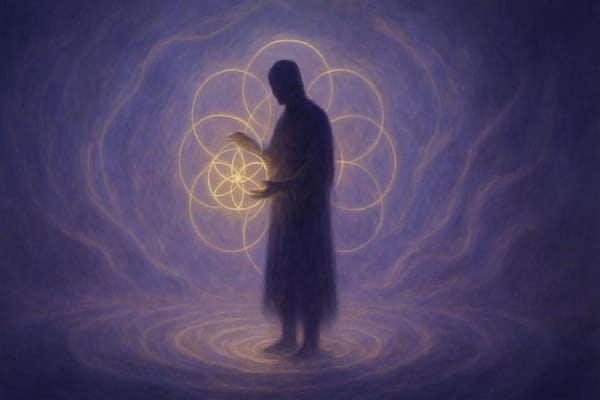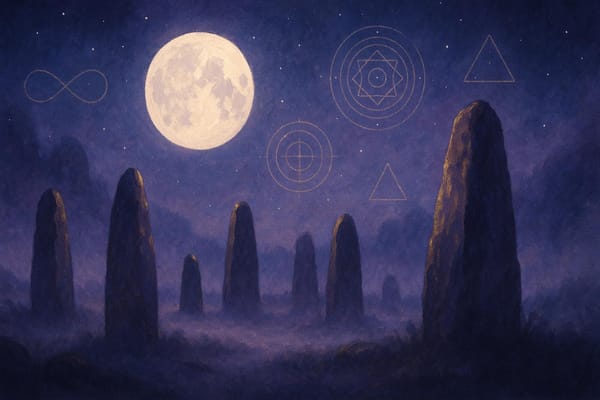Serpent Mound: The Lunar Serpent That Guards the Earth
Explore the ancient Serpent Mound in Ohio, a remarkable earthwork that reveals deep spiritual, astronomical, and geological significance.

Serpent Mound in Ohio is an ancient, snake-shaped earthwork over 1,300 feet long, built by Native Americans. It aligns with celestial events like the summer solstice sunset and the moon's 18.6-year cycle, showcasing advanced astronomical knowledge.
Resting on a 300-million-year-old meteor impact crater, its curves symbolize spiritual journeys in Shawnee teachings.
Key Facts:
- Location: Adams County, Ohio (3850 State Route 73, Peebles, OH).
- Dimensions: 1,348 feet long, 3.9–4.9 feet high, 19.7–24.9 feet wide.
- Celestial Alignments: Tracks solstices, lunar standstills, and moonrise positions.
- Cultural Significance: Represents spiritual enlightenment and energy connections.
- Visitation: Open year-round; parking costs $8 (free for Ohio History Connection members).
Whether you're interested in ancient astronomy, Native American spirituality, or geological wonders, Serpent Mound offers a unique blend of history and mystery.
The Fascinating Story of The Great Serpent Mound with Brad Lepper
History and Origins
Serpent Mound is more than just a visually striking structure - it holds layers of ancient knowledge and mystery. Archaeologists continue to debate its origins and the timeline of its construction.
Builder Theories
Radiocarbon dating has estimated the mound's initial construction to fall between 381 and 44 BCE, with an average date of 321 BCE. This timeframe aligns with the Adena culture, often credited as the original builders.
"Although artifacts taken by Putnam from the conical mound south of the serpent and from the lower level of the near-by village site cannot be positively assigned to the builders of the effigy, it is considerably less likely that the later Fort Ancient occupants built the serpent."
Frederic Ward Putnam's excavations in the 1880s provided the first detailed studies of Serpent Mound. Decades later, in the 1990s, researchers revisited the site, reexamining trenches and conducting new charcoal dating. These studies hinted at the mound's dual role, blending both practical and celestial purposes.
Astronomical Alignments
The layout of Serpent Mound reveals an impressive understanding of astronomy. For example, the tail aligns with the winter solstice sunrise, and the structure incorporates six distinct lunar sightlines.
William F. Romain's research delves deeper into this, showing how the curves of the mound form a sophisticated system for tracking lunar movements. This suggests the mound may have functioned as an ancient tool for astronomical calculations.
Mound Structure
The precision of Serpent Mound's design is reflected in its dimensions:
| Feature | Dimensions |
|---|---|
| Total Length | 1,348 feet |
| Height | 3.9 to 4.9 feet |
| Width | 19.7 to 24.9 feet |
Woodward & McDonald stated, "Serpent Mound represents the acme of prehistory effigy mound-building in the world and is part of a tradition of effigy mound building among American Indian cultures of the present Eastern United States."
Adding to its significance, the mound is situated atop a 300-million-year-old meteor impact crater. This unique location, combined with its precise construction, underscores its connection to lunar and celestial phenomena.
Lunar Connections
Serpent Mound's layout demonstrates an extraordinary level of astronomical understanding, particularly in its ability to track the moon's intricate cycles. This precision highlights its importance as one of the most fascinating ancient landmarks in North America.
Lunar Standstill Cycle
One of the mound’s most striking features is its connection to the moon's 18.6-year cycle, known as the lunar standstill. During this cycle, the moon's rising position shifts along the horizon, a pattern cleverly encoded in the structure itself.
The serpent's sinuous curves correspond to specific lunar positions. Researcher David Chandler explains:
"What I discovered when I started looking at the deviations from the average full moon rise positions was that the spread of actual moon rises around the average rise positions matched the widths of the eastward-bowing curves of the serpent's body. This sheds new light on the use of rounded moon rise pointers. The centerlines of the pointers mark the average full moon rises nearest the solstices and equinoxes and the widths of the curves indicate the range of variation."
The mound incorporates these lunar features into its design:
| Lunar Feature | Architectural Element | Purpose |
|---|---|---|
| Monthly Moon Rise | Northeast-Southeast sweep | Tracks the moon’s shifting rise positions monthly |
| Orbital Plane | Body curves | Reflects the variability in full moon rise points |
| Standstill Points | Eastward bows | Marks the extreme positions during standstills |
The next Major Lunar Standstill, expected between late 2024 and early 2025, offers a rare opportunity to witness these precise alignments. These details not only showcase the mound’s astronomical accuracy but also hint at its deeper energetic connections.
Energy Reports
In addition to its celestial significance, the mound is often described as having unique energetic properties. Researcher Ross Hamilton remarked:
"The Great Serpent Mound is not only the most astronomically sensitive ancient work in the world but also may serve as a teaching representative for all the classical geometric forms used by architects worldwide in the past. Astronomically, it possesses complete arrays of solar and lunar rising and setting points figured from sea level, a feat of design prowess unequaled anywhere else on the Earth."
The oval shape at the serpent’s head is thought to symbolize the sun or possibly a solar eclipse. Its carefully calculated alignments and strategic location suggest that it served multiple purposes - marking seasonal transitions and acting as a focal point of energy within the surrounding landscape.
Earth Energy Systems
Shifting focus from the stars to the ground beneath our feet, the geology of the Serpent Mound amplifies its energetic importance.
Geological Features
The Serpent Mound sits atop a fascinating geological formation known as the Serpent Mound Disturbance. This area is defined by three key features: a central uplift that rises over 1,000 feet, an outer rim that has dropped more than 400 feet, and a transitional zone that supports the mound itself. Adding to the intrigue, the site brings together three distinct soil types, creating an environment charged with energy.
"Serpent Mound was not built by aliens or lost tribes; it was built by American Indians."
– Marti L. Chaatsmith, Comanche, director of the Newark Earthworks Center of Ohio at the Ohio State University at Newark
This unique geological setting serves as a powerful foundation, enhancing the mound’s role as a hub of energy.
Energy Line Intersections
Beyond its celestial alignments, the Serpent Mound also connects with terrestrial energy pathways, further establishing its role as a multidimensional landmark. The mound is strategically aligned with Native American ley lines, making it a vital point in a network of sacred sites across the continent. Its location strengthens connections to other significant North American sacred sites.
Some researchers have even identified links between the Serpent Mound and Teotihuacan in Mexico.
Additionally, similar serpent-shaped mounds in Ontario and Scotland hint at a broader transcontinental energy connection. These alignments - both celestial and terrestrial - suggest that the builders possessed advanced knowledge of astronomy and geomagnetic forces.
To this day, the site holds deep spiritual meaning for Native American tribes, including the Shawnee, Eastern Shawnee, Miami, and Delaware peoples.
Current Site Uses
The Serpent Mound continues to serve as both a historical treasure and a hub for spiritual exploration, drawing energy from its celestial and earthly connections.
Visit Planning
Open year-round, the Serpent Mound welcomes visitors while maintaining its sacred character. Parking fees are $8.00 for vehicles and $4.00 for motorcycles, though Ohio History Connection (OHC) members can park for free.
Here are some highlights for visitors:
- Summer Solstice: The site will stay open until 9:30 p.m., offering a rare chance to see the serpent's head align with the setting sun.
- Archaeology Tours: Held on the second and fourth Fridays each month, these tours provide a closer look at the site's historical and cultural importance.
"Approach it as a place that is a sacred site and approach it with reverence and open-mindedness, that we may not today know -- and we probably never will know -- exactly what it meant to the people who built it, but it was important."
- Jen Aultman, World Heritage director of Ohio History Connection
Meditation Methods
The seven curves of the Serpent Mound, believed in Shawano teachings to represent spiritual gates, offer a serene setting for deep meditation and reflection. Visitors can explore various meditative practices, such as:
- Walking Meditation: Quietly reflect while following the mound's winding path.
- Shamanic Journeying: Engage in guided meditations to connect with the mound's ancient energy.
- Energy Work: Join retreats that include yoga, fire ceremonies, and sound baths.
Personal Experiences
Many visitors share stories of profound spiritual moments at the Serpent Mound, describing sensations of heightened awareness, healing energy, and a protective presence within the serpent's curves.
"The intention of the Earth Treasure Vase at Great Serpent Mound is to bring healing not only there, but to many other ancient sites and to bring healing to the souls of many ancient peoples whose molecular presence still exists within Gaia's soils, rocks, waters, and in the winds, in Her body and in the rays of sun and moonlight that shine upon Her."
These personal accounts highlight the enduring spiritual significance of the Serpent Mound, a site that continues to inspire transformation and connection across generations.
Conclusion
The Serpent Mound weaves together its astronomical, geological, and spiritual significance, standing as a testament to ancient ingenuity and a source of modern fascination.
Recognised as the largest surviving effigy mound and a National Historic Landmark, it offers a glimpse into the wisdom of its creators.
Built atop an ancient meteor impact crater, the mound’s design reveals a sophisticated understanding of celestial patterns.
Its head aligns with the summer solstice sunset, while its tail points to the winter solstice sunrise - a clear demonstration of its builders' knowledge of astronomy.
"Serpent Mound is truly a powerful sacred site. I actually feel very humble trying to give voice to it, but I can tell you how it affects me. A serpent is the symbol of mystery, we don't understand it, we know almost nothing about it.
When we interpret it, we mostly tell what we don't know. In that, I think, lies its power.
We feel we know so much, and yet we mostly live in an unknown universe, and I think Serpent Mound is that gateway to remembering that we don't really know anything. What we know is a particle or grain of sand on a beach."
The site serves as:
- A historical record, preserving the engineering and astronomical expertise of ancient Native American cultures.
- A spiritual hub, offering visitors a chance to connect with the Earth’s natural energies.
- An astronomical calendar, precisely aligned with key celestial events.
Today, the Ohio History Connection safeguards this remarkable site, ensuring its legacy endures for generations to come. Bridging Earth and sky, the Serpent Mound invites all who visit to reflect on our shared cosmic story.
FAQs
Why is the Serpent Mound aligned with celestial events like the lunar standstill and solstices?
The Serpent Mound’s alignment with key celestial events, like the lunar standstill and solstices, showcases the impressive astronomical understanding of its ancient creators.
These alignments likely served practical purposes, such as marking the passage of time, tracking seasonal shifts, and planning agricultural cycles. The way the serpent’s curves correspond with the sun’s positions during solstices and equinoxes suggests it functioned as an early form of a calendar.
However, its significance probably went far beyond practicality. This alignment likely carried deep spiritual meaning, symbolizing a connection between the earth and the cosmos.
The site may have been a sacred space for rituals or ceremonies celebrating the harmony between nature and the heavens. Its intricate design reflects a deep awareness of the interconnectedness between the terrestrial and celestial, making it a striking testament to the ingenuity and beliefs of its builders.
Why is the Serpent Mound's location on a meteor impact crater considered significant for its spiritual and energetic properties?
The Serpent Mound sits atop an ancient meteor impact crater, a feature that adds another layer of intrigue to its spiritual and energetic reputation.
Estimated to have formed around 300 million years ago, this crater disrupted the geology of the area in ways that many believe amplify natural energy. As a result, the site is often regarded as a natural hotspot for spiritual connection.
What makes it even more fascinating is the mound’s precise alignment with solar and lunar events. This suggests that its creators may have deliberately designed it to tap into both the earth’s energy and celestial rhythms for ceremonies or spiritual practices.
Together, these elements make the site a powerful destination for meditation, reflection, and connection, especially during significant lunar phases.
Who built the Serpent Mound, and what is its connection to astronomy?
The Serpent Mound in Ohio has long been associated with two Native American cultures: the Adena and the Fort Ancient. Initially, researchers believed the Adena constructed it between 800 B.C. and A.D. 100, based on burial mounds found nearby.
However, more recent radiocarbon dating indicates the Fort Ancient culture may have built it around A.D. 1070. This timeline suggests the site may have held evolving importance across generations.
What makes the Serpent Mound particularly fascinating is its alignment with major celestial events, including the summer solstice sunset and the equinoxes. These precise alignments highlight the builders’ advanced knowledge of astronomy.
The mound likely served as a ceremonial site or even a tool for tracking time, reflecting the profound connection between their spiritual beliefs and the movements of the cosmos.




